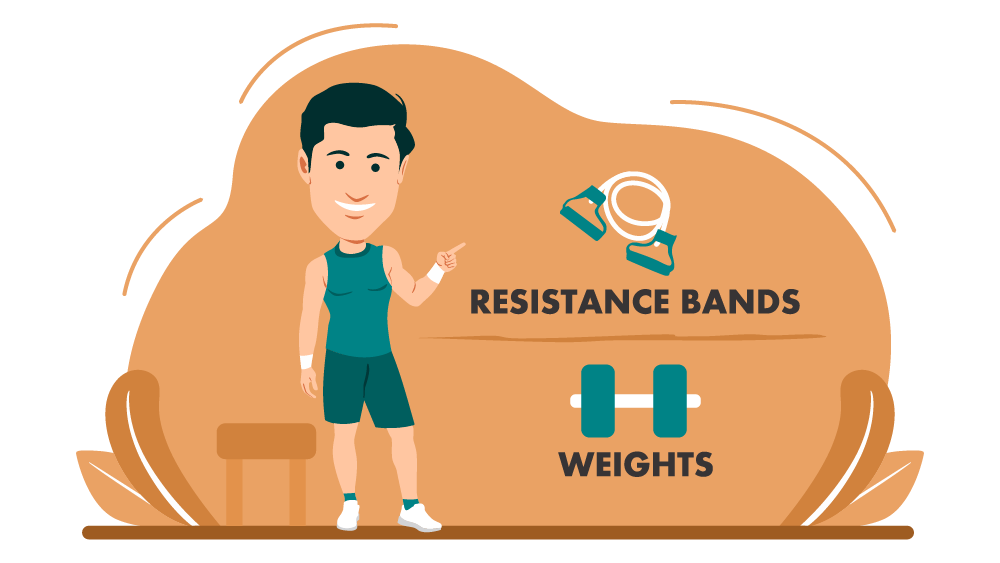When you want to work on your fitness, you might need to choose between resistance bands and weights. There isn’t a wrong or right decision. Both can help you get in better shape and increase your strength.
While they can both help you with your fitness, resistance bands and weights are not the same. Choosing the right option for you requires a full comparison of the two. Let’s look at what they both are and how they are different.

What are Resistance Bands?
TheHealthBoard.com states that resistance bands are “giant rubber bands that you pull against to strengthen certain muscle groups.” These bands are often used in strength training.
Resistance bands can be used to build muscle mass. They fall under a subcategory of weight training and provide an elasticity through the band that causes the resistance.
What are Weights?
SportsRec.com states that weights are “any type of weight training equipment that does not limit the range of motion with which you can use it.” Weights are often called free weights and offer a popular way to build muscle mass and strength.
Weight lifters can benefit in many ways from using weights. There are a few different types of weights, as well. Barbells, dumbbells, kettlebells, and a few others may all be considered weights.
Resistance Bands vs Weights: The Differences
Of course, the obvious difference is seen in what weights and resistance bands look like. Weights are bulky, heaving, hard to adjust, and hard to transport. Resistance bands, on the other hand, are smaller, lighter, and easy to transport.
The way they both work offers another difference. Weights put the residual load on your body while you’re in the rest portion of any exercise. Resistance bands, however, don’t do this. Instead, your muscle can actually rest during this part of the exercise.
You will notice another difference in the momentum of both. Weights will cause some of the exercises to be weightless due to the movement of the weight. If you’re doing a deadlift, for example, the momentum caused by the weight is used to lift the weight.
When you choose to use resistance bands, you won’t get this same momentum. Since resistance bands are very light, they don’t provide much help during the exercise.
Some of the benefits you gain from both show the differences, too.
Benefits of Resistance Bands
- Very portable and lightweight
- A wider range of motion
- Easier to train specific muscle groups
- Lower risk of injury from jarring or jerking your muscles
- More affordable
Benefits of Weights
- Focused training on specific muscles is easier
- Simple and intuitive
- Often feels easier during the workout
Resistance Bands vs Weights: Which is Right for You?
There is no single answer for your fitness goals. Resistance bands and weight both work very well if you want to perform strength training. In many cases, it can be beneficial to use both as a part of your regular workout routine.
However, if you don’t have much space or a small budget, resistance bands might be the perfect option. Those with a gym membership or a larger budget can likely take advantage of using both.
It really depends on your situation, as both resistance bands and weights offer many unique advantages.
The one scenario where resistance bands tend to be a much better choice is rehabilitation. If you’re rehabbing after an injury, resistance bands offer a safer choice than weights. They can also be easier to work with.
If you’re trying to get your workouts in and you travel a lot, resistance bands might fit better, too. You probably won’t be traveling with weights, but some hotel gyms may offer free weights you can use. However, having a set of resistance bands in your suitcase can ensure you get your workout in without depending on the hotel gym.
Frequently Asked Questions About Resistance Bands and Weights
Can I build muscle with resistance bands?
Yes, you can build muscle by using resistance bands. There really isn’t much difference in the results athletes see between using resistance bands and weights to build muscle.
Are resistance bands used for strength training?
Yes, both weights and resistance bands can be successfully used for strength training. If you work out with either one and you feel the soreness the next day, it worked.
How often will I need to replace resistance bands or weights?
If you decide to use resistance bands, they might dry out or crack over time. While this could take a few years to happen, they often don’t last as long as weights. The durability of most weights will allow them to outlast resistance bands and potentially last a lifetime.
Can I do all exercises with both resistance bands and weights?
No. There are some exercises resistance bands don’t work very well for and others weights don’t work very well for. Since weights are usually lifted in a specific direction, you won’t get the same range of motion. On the other hand, resistance bands are not suited for all exercises.
What type of resistance bands can I choose from?
Resistance bands come in a few different types. You can choose between power resistance bands or flat bands, tube resistance bands, figure 8 bands, mini bands, or light therapy bands. They may come in different lengths and resistance levels, as well.
Some types of resistance bands are similar in function, while others are quite different. For example, figure 9 bands are used mainly for lateral movements, while tube resistance bands are far more versatile.
What type of weights are available to choose from?
There are several types of weights to choose from. Most people will choose dumbbells, kettlebells, or barbells for home use. This is due to the smaller size and versatility. Sandbells and medicine balls might also be popular choices.
You can also find weight machines at a gym. There are several machines that perform one or two exercises per machine with weights.
Often, it’s helpful to have access to both resistance bands and weights. You can get the best of both worlds for your strength training when you choose to use both options.




